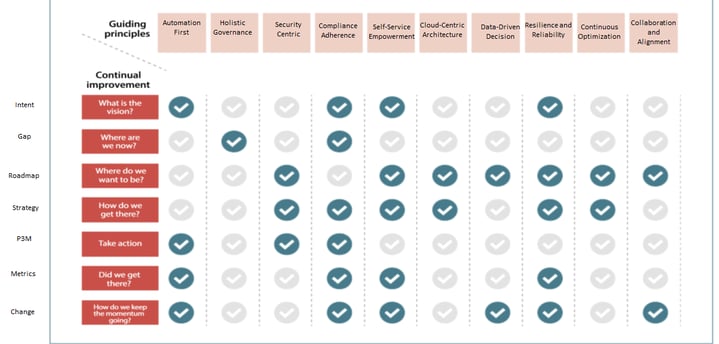Measuring the Maturity of One-Click Cloud Operation: A Path to Excellence Principles
Blog post description.


In today's fast-paced digital landscape, cloud operations have become a cornerstone of efficient and scalable business practices. One-Click Cloud Operation (OCCO) emerges as a compelling framework that not only streamlines cloud management but also paves the way for seamless deployment, agility, and innovation. However, the journey to OCCO excellence requires more than just its implementation—it necessitates the measurement of maturity across various dimensions.
Unveiling the OCCO Maturity Model
The OCCO Maturity Model serves as a strategic guide to assess an organization's progress in achieving One-Click Cloud Operation excellence. Just as a plant needs nurturing and care to blossom, an enterprise's OCCO capabilities require continuous refinement. This model offers a structured approach to evaluate maturity, enabling organizations to identify strengths, address gaps, and drive transformation.
The Path to OCCO Maturity
Foundation of Automation: At the nascent stage, OCCO implementation begins with embracing automation as the bedrock of operations. Efficient automation streamlines processes, accelerates workflows, and minimizes manual interventions.
Holistic Governance: Maturity grows as cloud operations expand their governance framework to encompass all facets—security, compliance, finance, data, and more. A comprehensive governance model ensures seamless coordination and control.
Data-Driven Insights: As OCCO evolves, organizations tap into the power of data-driven decision-making. Metrics and analytics offer invaluable insights into resource utilization, performance, and opportunities for enhancement.
Resilience and Reliability: OCCO's maturity journey includes fortifying cloud operations against disruptions. Building resilience and reliability ensures uninterrupted services, even in the face of challenges.
Continuous Optimization: Optimization becomes second nature, with a focus on cost efficiency, resource allocation, and performance enhancement. OCCO maturity drives organizations to refine their cloud environment continually.
Collaboration and Alignment: OCCO thrives when collaboration becomes the heartbeat of operations. Development, operations, and other business units harmonize their efforts, aligning goals to propel the organization forward.
Metrics for OCCO Maturity
Measuring OCCO maturity requires quantifiable metrics that reflect progress and outcomes. Key performance indicators (KPIs) for each principle offer a tangible way to gauge an organization's journey toward One-Click Cloud Operation excellence.
Automation First: Percentage increase in automated processes, reduction in manual interventions, and time saved through automation.
Holistic Governance: Number of governance areas integrated, level of cross-functional collaboration, and compliance adherence rate.
Data-Driven Insights: Utilization of data analytics tools, frequency of data-driven decisions, and improvements in resource allocation.
Resilience and Reliability: Downtime reduction, recovery time objectives (RTO) improvement, and increase in system availability.
Continuous Optimization: Cost savings achieved through optimization, improvements in performance metrics, and enhanced resource utilization.
Collaboration and Alignment: Number of successful cross-functional projects, alignment of objectives among teams, and frequency of collaborative initiatives.
Embarking on the OCCO Maturity Journey
Measuring OCCO maturity isn't a one-time endeavor—it's a continuous pursuit of excellence. By evaluating progress against these principles and metrics, organizations gain a clear roadmap to elevate their cloud operations. With OCCO maturity comes the ability to harness the true potential of cloud technologies, achieving operational efficiency, innovation, and business growth.
Here is Some of the key Metrics to help guide the Maturity Assessment.
Automation First:
Percentage of manual tasks automated.
Time saved through automation.
Number of successful automated deployments.
Reduction in human errors due to automation.
Increase in productivity and efficiency.
Holistic Governance:
Number of governance policies implemented.
Compliance score against industry regulations and internal standards.
Number of security incidents and breaches.
Percentage of cloud resources under governance control.
Alignment of cloud operations with business objectives.
Security-Centric Approach:
Number of security controls in place.
Time taken to detect and respond to security incidents.
Compliance score for security-related regulations and standards.
Number of vulnerabilities identified and remediated.
Number of security awareness training sessions conducted.
Compliance Adherence:
Percentage of compliance requirements met.
Number of compliance audits and their results.
Time taken to address compliance violations.
Number of compliance-related incidents.
Level of stakeholder satisfaction with compliance efforts.
Self-Service Empowerment:
Number of self-service requests processed.
Time taken to fulfill self-service requests.
Level of user satisfaction with self-service capabilities.
Reduction in IT support tickets due to self-service.
Increase in developer and user productivity.
Cloud-Centric Architecture:
Percentage of cloud-native applications and services.
Time taken to migrate legacy applications to the cloud.
Cloud resource utilization efficiency.
Scalability and elasticity of cloud resources.
Level of alignment with cloud best practices and frameworks.
Data-Driven Decision Making:
Percentage of data-driven decisions made.
Time taken to collect and analyze cloud operations data.
Impact of data-driven decisions on cloud performance and efficiency.
Level of data accuracy and integrity for decision making.
User satisfaction with data analytics and insights.
Resilience and Reliability:
Downtime and availability percentage.
Mean Time to Recover (MTTR) from incidents.
Number of successful disaster recovery tests.
Number of critical incidents and their impact on operations.
Level of system reliability and fault tolerance.
Continuous Optimization:
Percentage of cost savings achieved through optimization.
Resource utilization efficiency improvement over time.
Time and effort saved through continuous optimization.
Number of performance improvements implemented.
User satisfaction with optimized cloud resources.
Collaboration and Alignment:
Level of cross-functional collaboration and knowledge sharing.
Number of successful cross-functional projects and initiatives.
Time and effort saved through improved collaboration.
Level of alignment between cloud operations and business goals.
Stakeholder satisfaction with collaboration efforts.
These metrics can provide valuable insights into the effectiveness and impact of the OCCO model in driving successful cloud operations and meeting business objectives. Regular monitoring and analysis of these metrics can help organizations identify areas for improvement and make data-driven decisions to enhance their cloud operations.
